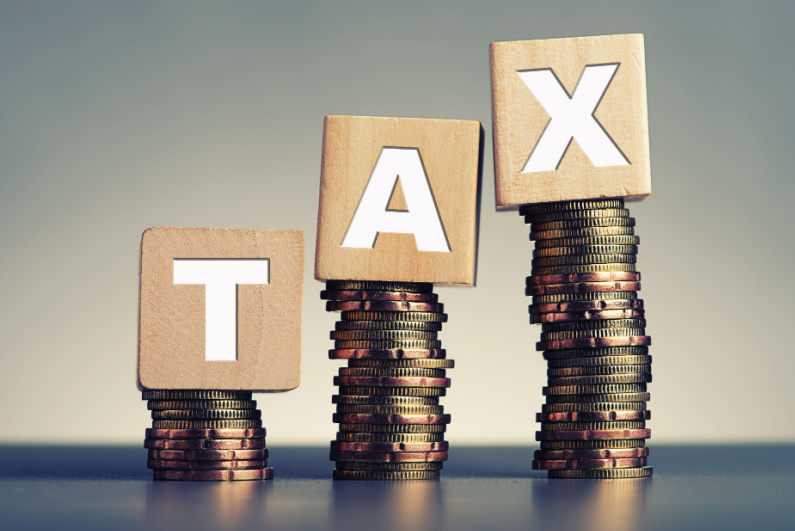The market is erupting
US sports betting was legalized with the repeal of the Professional and Amateur Sports Protection Act in May 2018, five years ago this month—and it has created a feverish outpouring of support nationwide.
Americans have bet over $220bn (roughly the national GDP of Portugal)
A total of 37 states have legalized sports betting since the famous 2018 Supreme Court decision. Americans have bet over $220bn (roughly the national GDP of Portugal) during that time, yet each state’s market has its own set of standards, one of which is the tax rate.
But what effect does the tax rate have on sportsbooks’ longevity, profitability, and patronage? And just how large of a variance is there in the tax rate from state to state? VegasSlotsOnline News sets out to answer these questions.
State-by-state tax
Here’s a comprehensive overview of every state’s sports betting tax breakdowns:
| State | Retail Tax % | Online Tax % |
| Arizona | 8% | 10% |
| Arkansas | 13% of first $150m20% on remaining rev. | N/A* |
| Colorado | 10% | 10% |
| Connecticut | 13.75% | 13.75% |
| Delaware | 50% | 50% |
| Illinois | 15% | 15% |
| Indiana | 9.5% | 9.5% |
| Iowa | 6.75% | 6.75% |
| Kansas | 10% | 10% |
| Kentucky | 9.75% | 14.25% |
| Louisiana | 10% | 15% |
| Maine | 10% | 10% |
| Maryland | 15% | 15% |
| Massachusetts | 15% | 20% |
| Michigan | 8.4% | 8.4% |
| Mississippi | 12% | N/A |
| Montana | Varies | Varies |
| Nebraska | 20% | N/A |
| Nevada | 6.75% | 6.75% |
| New Hampshire | 51% | 51% |
| New Jersey | 8.5% | 13% |
| New Mexico | Varies | Varies |
| New York | 10% | 51% |
| North Carolina | N/A | N/A |
| North Dakota | N/A | N/A |
| Ohio | 10% | 10% |
| Oklahoma | 15% | 15% |
| Oregon | Varies | Varies |
| Pennsylvania | 36% | 36% |
| Rhode Island | 51% | 51% |
| South Dakota | 9% | N/A |
| Tennessee | N/A | 20% |
| Virginia | 15% | 15% |
| Washington | N/A | N/A |
| Washington D.C. | 10% | 10% |
| West Virginia | 10% | 10% |
| Wisconsin | Varies | Varies |
| Wyoming | N/A | 10% |
What do the numbers mean
Using the information above and analyzing performances in different state markets, we can draw several conclusions.
lower tax rates are more conducive to long-term growth
First, states have generally found that lower tax rates are more conducive to long-term growth and harmony between themselves and the sports betting operators. If we look at Pennsylvania and Illinois, which both have similar populations of around 12.5 million, it appears that the former’s high tax rate of 36% may have impeded progress. Illinois has already surpassed Pennsylvania in sports betting revenue despite launching 16 months later in March 2020, although Pennsylvania’s high rate means the state has made nearly double Illinois in tax.
The glaring exception to the rule is New York which, despite having a 10% tax on retail sports betting revenue, takes 51% of online proceeds. That has not stopped the Big Apple sportsbooks from producing the highest average monthly return in the nation since launch, generating $1.36bn in gross gaming revenue in 2022. New York has taken in nearly $1bn in all-time sports betting tax, although this begins from the launch of its retail market in 2019.
Another conclusion is that, excluding New York’s online operations, the states with the highest tax rates (New Hampshire and Rhode Island) are in extremely small markets. The reason for the high tax is that there are no local professional sporting attractions, and the population is so small that the state needs to take other measures to churn out the necessary funding.
On the flip side, states with robust and active markets such as Nevada, Ohio, Michigan, and New Jersey have lower tax rates than most other states. That falls in line with the supply-demand principle; the supply (of bettors) is much higher in these areas, so the demand (for a higher tax rate) is lower. New York and Pennsylvania stand alone as outliers to this.
Other factors to consider
While it seems that tax rates do have some impact on overall sports betting profitability, there are also a number of other factors that need to be taken into consideration. For instance, quite simple, states with a higher population have more chances to turn people into players. States with local professional sports teams—especially successful ones—also have a much easier time converting sports fans into true sports bettors.
Ohio accordingly reported a first-month betting handle of more than $1bn
For example, Ohio launched its sports betting market on January 1, 2023. By the end of the month, the Cincinnati Bengals had played three NFL playoff games, including the AFC Championship Game against the soon-to-be Super Bowl champion Kansas City Chiefs. Ohio accordingly reported a first-month betting handle of more than $1bn and claimed a staggering $208m in revenue. For comparison, that’s more than what 12 states with legal and active sports betting markets have made since launching the vertical.
States also go through ups and downs depending on the time of the year in the sports calendar, and while that may not be unique to each jurisdiction, it helps if that state has teams playing at a certain time of year. Everyone loves to throw down a bet on March Madness, but Pennsylvania and Virginia bettors will be more incentivized to do so if Villanova is taking on UVA in the national championship game.
The bottom line is that sports betting is here to stay. The majority of America has already legalized it, and most of the remaining states are actively searching for paths to legalization. Don’t be surprised to see continued growth and more blurred lines between simple sports fandom and sports betting.




